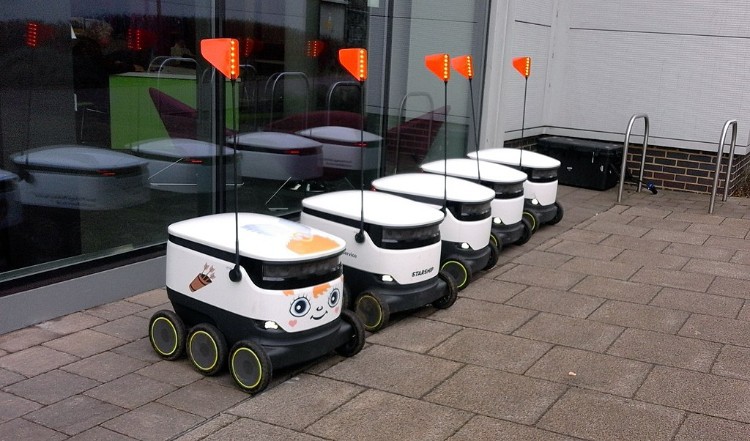How Soon Will Robotic Delivery Become Mainstream?

We see it in any movie or television show that gives us a glimpse of the future — robotic delivery. In Ready Player One, everything from pizza to online orders is delivered by drone. In Passengers, a robotic bartender named Arthur — played by the ineffable Michael Sheen — serves up drinks continually. In Black Mirror we also see a dystopian future where an autonomous pizza delivery truck strikes a pedestrian and according to Curbed, “the plot hinges upon a seemingly small detail Mia witness from her window.”
Sci-fi is clearly fascinated by this subject, but how long will it be until robotic delivery becomes mainstream? Let's take a closer look at what it will take to turn these fictional delivery-bots into reality and those who are working on getting them onto the streets.
The Growth of Last Mile Delivery
Have you noticed how much longer online deliveries are taking these days? Sure, if you order from Amazon, you can be pretty sure that your stuff will be there in two days or less but other sites are struggling to keep up with those last-mile deliveries. That's because people are ordering online more than ever before — between 2016 and 2017, online orders increased by 16%. Consumers are ordering meal kits instead of going to the grocery store, and all of these deliveries from the warehouse to your home are classified as last mile deliveries. They're on the rise, and delivery services like USPS, UPS, and FedEx are struggling to keep up.
The last mile problem isn’t the only reason that companies like Amazon are working toward creating a drone delivery fleet. One study found that self-driving vehicles and autonomous drones could lower last-mile delivery costs by up to 40%. It will also end up being better for the environment since all of the drones and robots carrying out the deliveries are electric, so no emissions.
Who's Working on Robotic Delivery?
There are quite a few companies that are working toward robotic delivery and many of them are already testing their drones and sidewalk robots in limited areas.
Postmates has introduced Serve, a tiny electric robot that can deliver up to 50lbs of whatever you want to order in up to a 30-mile radius. Postmates is currently testing Serve in Los Angeles, and we have to say that it's big blinking 'eyes' are adorable.
Starship is a delivery robot company based out of Estonia that is testing their cooler-shaped delivery robots in Washington right now. Amazon's Scout robots look remarkably like Starships delivery bots, but the retail giant isn't butting heads with Starship — the Estonian company is happy to see other companies realizing the potential contained in delivery bots.
Dominoes is using robots to deliver pizza in New Zealand, and PepsiCo rolled out snackbots to feed the ravenous students on the University of the Pacific campus in California.
These are just a few of the companies that are working on robotic delivery but they all have one major thing in common — they're all being tested in limited locations and all of those locations are in highly populated urban centers. Ground-based delivery robots will likely be limited to urban areas, so that's where aerial drones come in.
Making Aerial Drones Safe
Drones are already making deliveries in the international scene. Zipline, a drone company based in California, deployed a vaccine delivery network in Ghana that will use drones to deliver medicine, vaccines, and blood to clinics throughout the country. This is possible in part because there isn't as much air traffic in Ghana as there is in developed countries like the United States.
Drone technology is almost ready to swarm the skiesDrones are ready to take off (finally!). They're going mainstream, helping deliver medical supplies, inspecting hard to reach places, responding to emergencies, and yes, delivering online orders. This week Quartz News looks at how very close we are to making drones safe enough to operate across the skies. Follow Quartz News for weekly dives into the stories shaping our future and culture and tune in every Thursday at 12pm eastern for new episodes.
Posted by Quartz News on Thursday, April 25, 2019
In 2018, the Federal Aviation Administration (FAA) launched a program to test-fly drones across the country to see how they can incorporate these flying delivery bots into the already busy skies above the U.S. The goal is similar to what is already working in Switzerland — a program that lets drones communicate with air traffic controllers so there are no mid-air collisions and drones and planes can share the same airspace.
We won't see aerial delivery drones for a while yet, but companies are working with the FAA to make it a reality in the near future.
When Will Robotic Delivery Become Mainstream?
It's hard to say when robotic delivery will become mainstream. Most of the test cities are taking to the little delivery robots well, though there have been some setbacks — like when a Kiwibot caught fire on the University of California Berkley Campus where it had been making deliveries for two years. That fire was blamed on a defective battery. It probably won't be too long before we start seeing Postmate or Amazon delivery bots in cities across the country — but it's not quite there yet.
last one i swear pic.twitter.com/by53PJANiL
— 🥑 (@brlohn) December 14, 2018
E-commerce is here to stay, and robotic delivery may be the missing piece of the puzzle to make last-mile deliveries faster and more cost effective.
Thanks for helping to keep our community civil!
This post is an advertisement, or vandalism. It is not useful or relevant to the current topic.
You flagged this as spam. Undo flag.Flag Post


